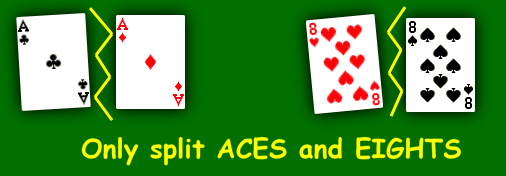The ace is the most valuable card in a blackjack game. It may be used as a 1 or 11, whichever is more advantageous for a hand. It is also half of the hand that makes a blackjack, which pays 3-2 at most tables.
A pair of aces is the best start hand in Texas Hold’em. Blackjack is not much different. Split aces allow a player at least two chances to win. In some cases, there are up to four chances to win in a single hand, each containing the best card in the deck.
The standard payout for a blackjack is 3 to 2. Never play blackjack offering 6 to 5 or any other payout of less than 3 to 2. (Certain blackjack variations may be playable while offering lower payout for blackjack, but you need to investigate these games separately. Payouts on split hands are always 1-1. If a natural is dealt to a split hand, it is not paid as a blackjack and is still eligible for a push. If you win a split hand, a $10 wager will be matched at the side before your cards are cleared and mucked. Insurance, the Sucker Bet.
Can You Split Aces In Blackjack
The overall consensus by blackjack strategists is to always split a pair of aces, no matter what, as two hands with a value of 11 each extend much better opportunities of a win than one single hand valued at 12 or two. The total blackjack payout, then, partially depends on your wager. 3:2 is the payoff for a blackjack. To win the blackjack payout of 3:2, your hand must consist an Ace and a face-card or a ten card. Facecards have a value of 10 in blackjack Such card combination is referred to as natural 21 or blackjack.
If you split Aces, only 1 card will be dealt for each hand. Insurance payouts on Blackjack Early Payout are 2:1. This game is a unique variant of Blackjack Surrender, where players can cash in before the dealer has completed their hand. Experts recommend using basic blackjack strategy with early payout.
Re-split aces
Some Las Vegas casinos will allow players to re-split aces. This means that if a player receives another ace after splitting aces, the hand may be split again for another bet. Casinos that offer re-split aces will allow up to four hands if aces continue to come off the top of the deck. A blackjack game that allows aces to be re-split has a house edge that is .08% lower than one that does not, assuming that all of the other rules are otherwise the same.
Split Aces Blackjack Payout Odds
Hitting Split Aces
All standard blackjack games do not allow hitting split aces. This is due to the fact that it would drop the house edge by .19%. Most blackjack games have a house edge of .5% or lower. The house must have an edge that covers its overhead.
What Happens If You Split Aces In Blackjack
Allowing split aces to be hit would also increase the variance. Imagine a hand where a player gets four aces in a row and split them into four hands while having the ability to hit and maybe even double down. That would be a blackjack dream hand.
There are two blackjack variations that allow split aces to be hit. They are Super Fun 21, known as Super 21 at Real Time Gaming online casinos, and World’s Most Liberal 21. These games also pay even money on most blackjacks and have a higher house edge than most blackjack games.
Doubling Split Aces
A house that allowed doubling after splitting may also have to include aces for consistency. Allowing a double down on split aces would take another .08% from the house edge. Super Fun 21 and World’s

Most Liberal 21 allow double down after splitting and re-splitting aces. As mentioned, these games short pay on a natural blackjack. Triple Attack Blackjack allows double down on split aces but does not allow players to hit them.

Getting 21 on Split Aces
Splitting aces and receiving a ten-value card will look identical to receiving a dealt blackjack off the top of the deck. This does not count as a natural blackjack. It simply counts as any other 21 would and does not automatically win. It would tie the dealer if the house also made a 21 hand.